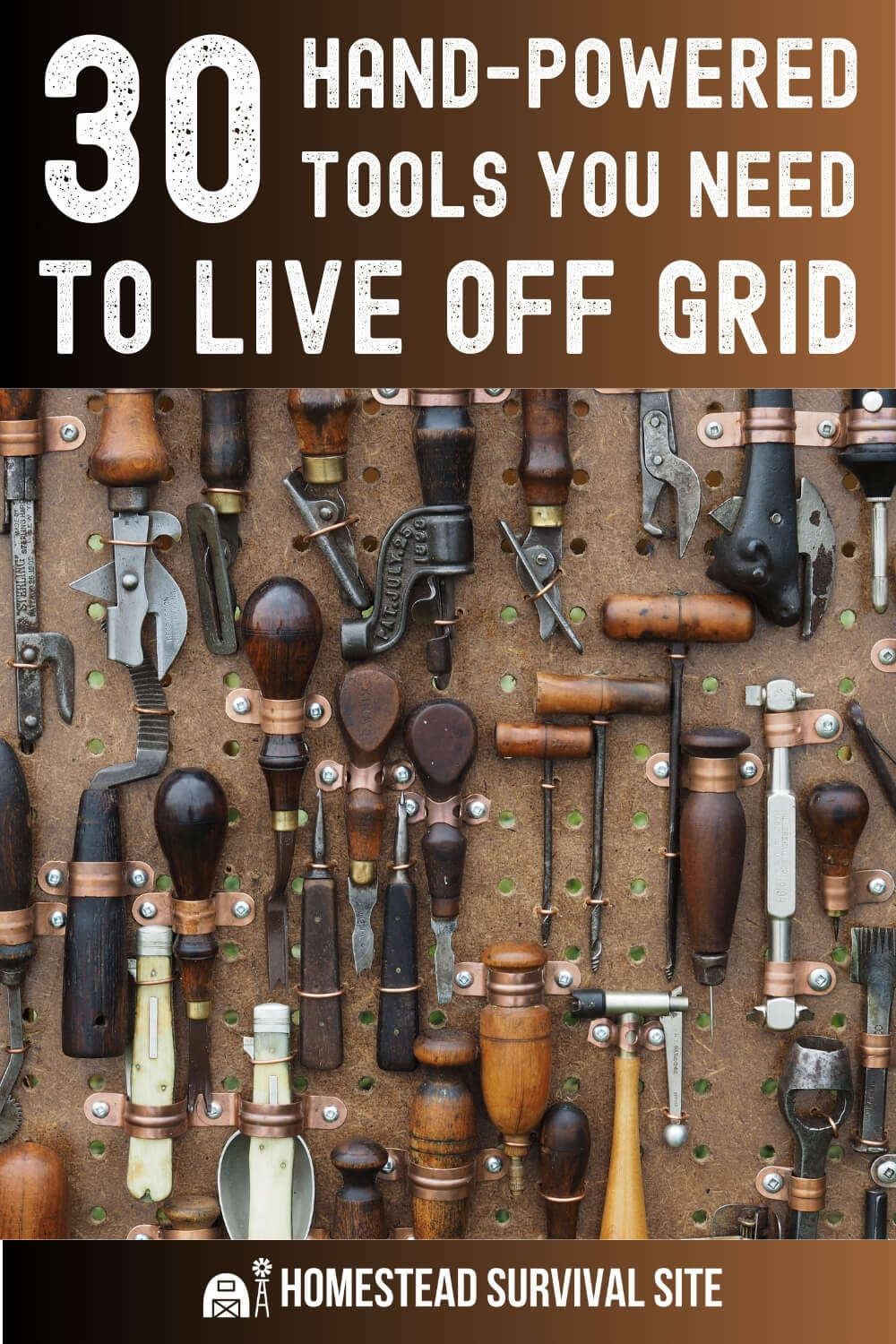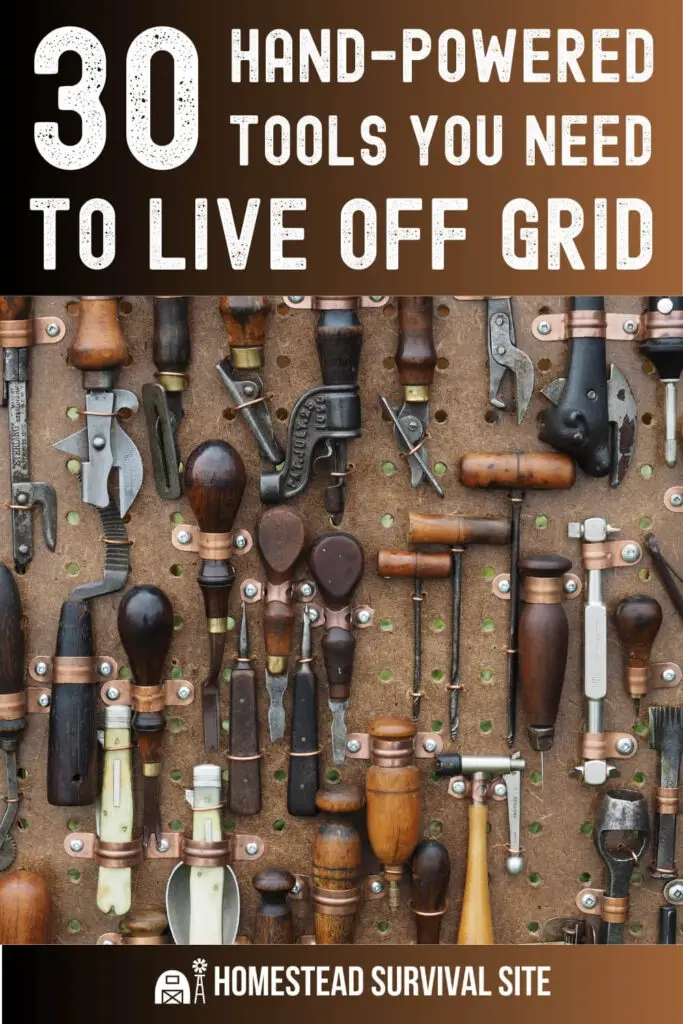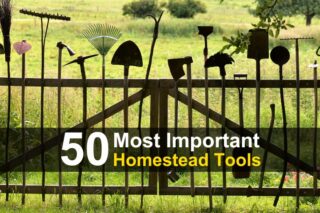Estimated reading time: 10 minutes
Preppers need tools, lots and lots of tools – of the manual variety. It would be unwise to expect to use power tools during a long-term disaster, even if the inciting incident had nothing to do with an EMP or cyber attack on our electrical grid.
Sooner or later, your fuel stockpiles and spare chainsaw blades will run out. When they do, you must not only have a healthy stockpile of hand-powered tools, you must know how to use them.
As with all things related to prepping, cross-training of skills is necessary when it comes to tool use, even the seemingly simple kitchen tools our pioneering ancestors once used. If the only person who knows how to cut wood with a manual saw becomes incapacitated or killed, the family could die of exposure.
Unless you have very deep pockets, you probably can't run out and buy all the manual tools you need all at once. But printing off a list of essential manual tools and adding the cost to your prepping budget should allow you to accumulate them over time…hopefully before the SHTF.
Want to save this post for later? Click Here to Pin It On Pinterest!
Some of these manual tools (perhaps many, depending upon where you live) will not be super easy to find – they are not typically sold at the local mall. Rural preppers, as with most things survival related, have an edge on their suburban and urban peers when it comes to tools for two distinct reasons:
- Rural preppers work outdoors and repair both broken items and issues around their property on a regular basis.
- Self-reliant rural residents also have far more space to stockpiles of tools that urban and suburban preppers.
But a lack of experience and storage space should not deter non-rural preppers from acquiring tools that will help them survive a doomsday scenario. Tools they may not have any use for right now could become essential to everyday life, second only to water and shelter when the SHTF.
18 Outdoor Manual Tools
Auger
Using an auger or a post hole digger (get one of those as well) is a lot of back-breaking work if you are setting wood posts to create a fence line, but when modern farm implements are no longer functioning due to a lack of fuel, you will be grateful for each and every blister that you get creating a barrier around your barn, garden, or home, with a manual auger.
Broadfork
This mighty tool has two long handles and a series of sharp tines at the bottom. You step on the crossbar and use your weight to drive those tines deep into the soil, then pull back on the handles to aerate your garden beds without flipping the soil layers.
This not only saves your back from the strain of traditional digging but also preserves the soil structure and keeps those helpful earthworms doing their thing. Plus, in a pinch, the broadfork can double as a hefty tool for clearing out debris or as a barrier against unwanted critters.
Claw Hammer
There are a plethora of different types of hammers you should have in your prepper stockpiles, but the claw hammer is likely the most versatile. It can be used for pounding nails, cracking ice, chopping roots and small trees, prying wood or metal apart, breaking many different types of items open, and of course, as a weapon.
Flail
The flail is an age-old agricultural tool. It's used for manually threshing grains and separating seeds from their husks. This simple device, consisting of a handle attached to a shorter, free-swinging stick, can also be used to crush dried corn or small nuts. It was also commonly used as a weapon.
Foot-Powered Lathe
This versatile tool is used for shaping wood, metal, or other materials into round objects. It’s mainly used for woodworking tasks like turning wooden bowls, spindles, or decorative pieces. The lathe holds the material in place while it spins, and you use various tools to shape the material as it rotates.
Grinding Wheel
This traditional blade-sharpening tool will help keep all of your knives and many of your manual tools, like the machete and hatchet, in proper working order.
Hack Saw
A hacksaw can be used to cut wood boards, metal pipes, metal chains, plastic pipes, and similar materials.
Hand Drill
It will take a lot more elbow grease to complete a task with a hand drill as opposed to a power drill, but the job will still get done. Look for a complete hand drill set to ensure you have a variety of bits that fit the manual tool.
Hand Saw
The hand saw will replace the chainsaw for cutting wood once the fuel supply is no longer finite. It is highly advisable to invest in both a single person crosscut saw as well as a two-person crosscut saw so you can cut down large trees.
Hatchet
The hatchet has not changed in design or material construction since its inception. They're still available with solid wood handles but also come with sturdier metal handles. They can be used to butcher meat, cut bone, chop wood, chop down small trees, break ice, break glass, or chop through a wood door, just to name a handful of uses. When the blade is properly tended to, a hatchet makes an excellent weapon as well.
Machete
A machete can definitely be used as a weapon, but it can also be used to kill wild game, butcher meat, force hard nuts open, cut poles out of small trees to build a shelter, cut brush and weeds, and to shave wood to make tinder.
Multi-Tool
No prepper should be without a good multi-tool. There should be one in every survival pack, in the car, and inside the home as well. These small, lightweight tools contain scissors, a knife with a serrated edge, both a flathead and a Phillips screwdriver, awl, wire cutter, pliers, a can opener, and more.
Pry Bar
This sturdy tool does not take up much space and can be worth its weight in gold. A pry bar (or crowbar) will open doors, can be used for leverage to lift heavy items, to break locks, to pry apart objects, and as a weapon.
Scythe
A scythe is an old-fashioned gardening tool that not only cuts down dense weeds, it also helps you clear space for a growing plot and turn the soil over after the harvest to prepare it for the next year.
Shovel
Shovels come in many shapes and sizes. At the very minimum, you should have two folding shovels designed to fit into a backpack – even if you are pressed for storage space. Shovels can be used to dig trenches to catch water and to contain a fire, to dig a latrine, to plant crops, to remove mud and snow, and as a weapon.
Spade
This is perhaps the most useful manual gardening tool you will ever own. A spade can be used to turn soil, make holes for seeds or plants, chop weeds, and as with most outdoor manual tools, double as a weapon.
Water Pump
A manual water pump can be a lifesaver in situations where you need water from a well but don't have electricity. Water pumps come in various designs, including hand-operated and foot-pump models. The ability to install, operate, and maintain a manual water pump is a vital skill, ensuring access to clean water for drinking, irrigation, and hygiene.
Wheelbarrow
A good old-fashioned wheelbarrow doesn’t require fuel to operate. It’s crucial for transporting soil, compost, firewood, and other bulky or heavy materials across your property. Its design has stood the test of time, proving invaluable for a wide range of tasks from construction projects to daily chores.
Top 12 Kitchen Manual Tools
Butter Churn
This is used to turn cream into butter by agitating it, which separates the butterfat from the buttermilk. You start with heavy cream, pour it into the churn, and then use a plunger or a crank to vigorously stir the cream.
This process thickens the cream into whipped cream and eventually separates it into solid butter and liquid buttermilk. The butter solids are then collected, rinsed, and pressed to remove excess liquid, resulting in fresh, homemade butter ready for use.
Jar Opener
A jar opener is a simple yet effective tool should not be overlooked. With its adjustable design, it can open jars of various sizes, providing access to preserved foods with minimal effort. Its durability and ease of use make it a valuable asset for preparing meals without electricity.
Hand Crank Grain Mill
A hand crank grain mill is a pioneer-era kitchen manual tool you can grind wheat, corn, and acorn into flour to make bread.
Hand Utensils
These are inexpensive kitchen hand tools that you will need when cooking from scratch or putting up food from the harvest. Examples include: potato masher, butter churn, rolling pin, cheese grater, whisk, potato peeler, whisk, ladles, meat tenderizing hammer, measuring cups, measuring spoons.
Manual Can Opener
All the commercially canned food must be opened before it can be consumed. Doing so with a knife is feasible, but it is not the safest method and it will dull your knife. Make sure you have a manual can opener.
Manual Ice Cream Maker
A manual ice cream maker allows you to make ice cream by hand, using a simple mechanism that involves a hand-crank. To use it, you fill an inner container with your ice cream mixture, then place it inside a larger outer bucket filled with ice and rock salt. The salt lowers the temperature of the ice, helping to freeze the mixture evenly. +
You then turn the hand-crank to stir the mixture, which prevents large ice crystals from forming and helps achieve a smooth, creamy texture. After about 20 to 30 minutes of cranking, you'll have freshly made ice cream ready to enjoy.
Mortar and Pestle
Before electric blenders and food processors, there was the mortar and pestle. This tool is essential for grinding spices, making pesto, or creating pastes and marinades from scratch. A mortar and pestle allows for precise control over the texture of what you're grinding, bringing out the full flavor of ingredients in a way that electrical appliances can't replicate.
Percolator
You can still make your morning cup of coffee or medicinal tea by putting a percolator directly on a wood cook stove, wood burner, or on a metal grate over a campfire.
Solar Dehydrator
With a solar dehydrator, you can use the sun to cook or dry your herbs, foraged greens, natural medicine ingredients, garden harvest, and even meat.
Tea Kettle
You can heat water for cooking, making tea and coffee, purifying water. I recommend a cast iron tea kettle on a wood stove or over an open flame.
Water Bath Canner and Pressure Canning Equipment
During an SHTF event, you need to not only grow and hunt or your own food but preserve it as well. Get a water bath canner and stock up on canning pots and related items like Mason jars, rings, and lids so food can be put up for the winter and beyond both now and during a disaster scenario.
Wood Cook Stove
This will be the most expensive and largest manual kitchen tool you can buy, but it will be worth every penny when you are struggling to keep warm and cook food during a long-term disaster. Many Amish folks in my area use wood cook stoves on a daily basis right now for just those purposes. They work wonderfully (even for water bath and pressure canning) and can heat an entire house floor.

A wood cook stove is a wood burner and a stove combined in one. This versatile off-grid kitchen tool functions just like a regular stove and oven, but it heats with wood logs instead of electricity or gas. It will take some time to learn how to regulate the heat if you are not used to living with a wood burner or fireplace in your home, but the concept is not difficult to master.
This is not an exhaustive list of outdoor manual tools and indoor kitchen manual tools, but it does showcase the most important items that can vastly increase your chances of surviving a long-term disaster…and make living through a short-term one a lot easier and more comfortable.
Like this post? Don't Forget to Pin It On Pinterest!
You May Also Like:













No mention of a tape measure or ruler.
Or some way to weight things either.
Good point. I guess one could make one of his own fashion, according to his need(s).
In addition to a hand drill, I would suggest a complete set of Brace and Bits 1/4″ to 2″ in 1/4″ increments. Though a little more work than a hand drill, these bits actually pull themselves through the wood being drill, and were used to make mortise and tenon joints for nailless (dowel pin)construction.
Look for them at any yard sale where old tools are being sold. My set cam to me from my Great Great Grandfather and are well over 100 years old.